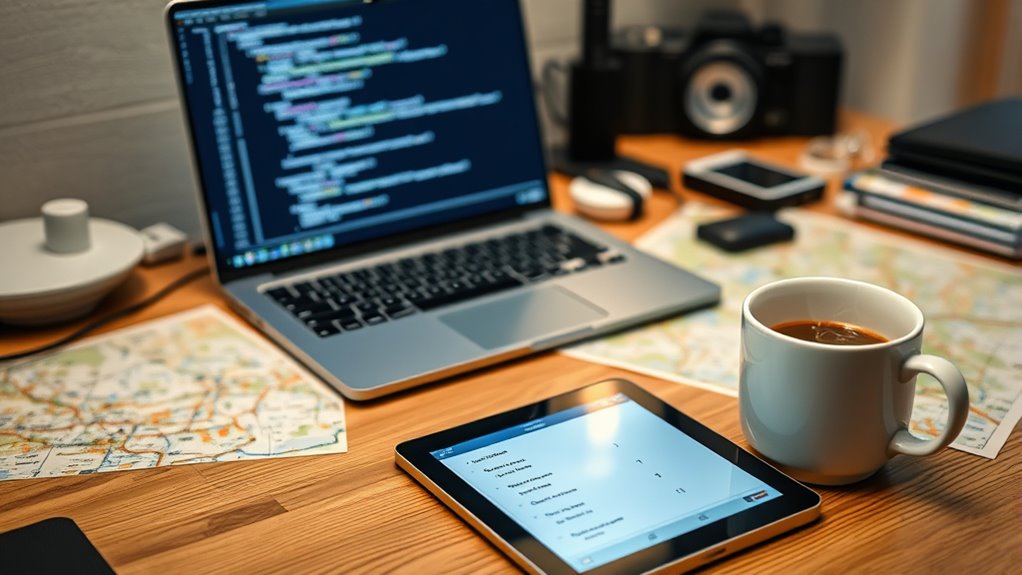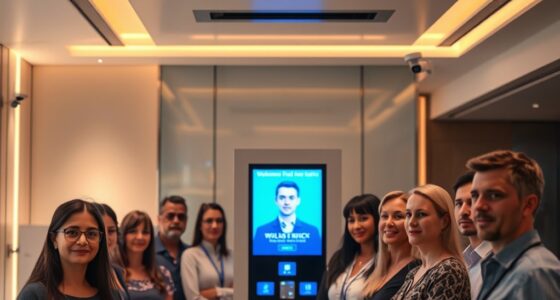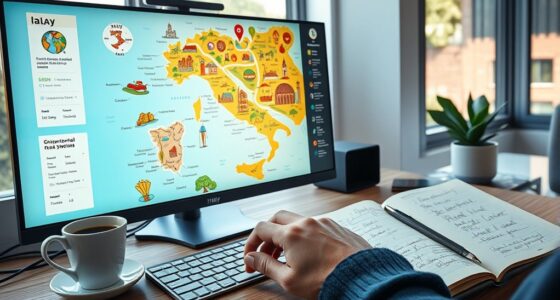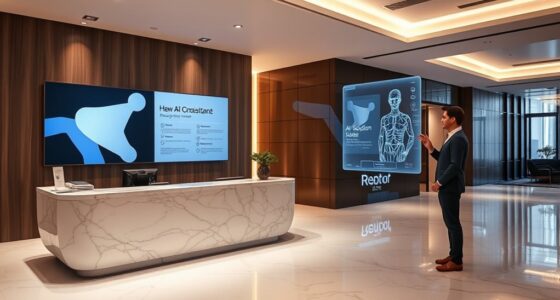To set up a local LLM for offline itinerary planning, start by selecting a model that fits your hardware capabilities. Download the necessary weights and install open-source tools for easy setup. Configure the environment on your device, whether it’s a desktop, server, or Raspberry Pi, ensuring the model runs smoothly with quick responses. With the right setup, you’ll keep data private and have instant access to personalized travel suggestions—continue to explore how to make this process seamless.
Key Takeaways
- Choose an LLM compatible with your hardware’s processing power and memory capacity.
- Download and install the model weights locally, ensuring proper environment setup.
- Configure the LLM for offline operation, focusing on quick response times and resource management.
- Integrate the LLM into a custom interface or app for user input and trip parameter processing.
- Regularly update and fine-tune the model with travel data to improve itinerary suggestions.

Planning your trips offline is now easier than ever with a local large language model (LLM). Setting up an LLM on your own device allows you to generate personalized itineraries without relying on internet access or third-party services. To get started, you’ll need to focus on model deployment—installing and configuring the model to run efficiently on your hardware. This process involves selecting a suitable LLM, downloading the necessary weights, and setting up the environment, whether on a powerful desktop, server, or even a dedicated Raspberry Pi. The key is ensuring the model runs smoothly and responds quickly to your input, providing real-time itinerary suggestions and adjustments.
Deploy a local LLM for offline trip planning with personalized, secure, and quick itinerary suggestions.
One of the biggest advantages of deploying a local LLM is enhanced data privacy. When you keep all your trip data, preferences, and plans on your device, you eliminate the risks associated with transmitting sensitive information over the internet. You don’t need to worry about third-party servers storing or potentially misusing your data. This level of control is especially important if you’re planning trips with personal or confidential details, such as family itineraries, medical appointments, or business meetings. By managing the model locally, you retain full ownership of your data, reducing vulnerabilities and ensuring your privacy stays protected.
Setting up a local LLM also involves managing updates and fine-tuning. Unlike cloud-based models that are maintained and updated automatically, a self-hosted model requires you to stay on top of updates and improvements. You might want to fine-tune the model with your own travel-related data or preferences, making it more accurate and tailored to your needs. This customization enhances the model’s ability to suggest unique itineraries, recommend hidden gems, or adapt to specific travel styles. Additionally, understanding hardware requirements such as sufficient RAM and processing power is crucial for optimal performance.
While deploying a model locally requires some technical knowledge, many open-source tools and tutorials are available to streamline the process. You’ll need to think about hardware requirements, like sufficient RAM and processing power, as well as software dependencies. Once set up, you can integrate the LLM into a simple interface—perhaps a custom app or command-line tool—that allows you to input your trip parameters and receive instant, personalized suggestions.
Frequently Asked Questions
What Hardware Is Required for Local LLM Deployment?
For local LLM deployment, you need a powerful GPU to handle model processing efficiently. Aim for at least an NVIDIA RTX 30 series or higher. Storage solutions should include fast SSDs to quickly access data and models. Guarantee you have sufficient RAM, typically 16GB or more, to support smooth operation. These hardware specs help your system run LLMs effectively, providing quick responses for offline itinerary planning.
How Secure Is My Data With a Local LLM?
Like a knight safeguarding a treasure chest, a local LLM protects your data by keeping it on your device. Your data stays secure through data encryption, preventing unauthorized access. Plus, you control privacy policies, so your information isn’t shared or sold. While no system is invulnerable, a local LLM substantially reduces risks associated with data breaches, giving you peace of mind that your personal info stays private and protected.
Can I Customize the LLM for Specific Travel Preferences?
You definitely can customize the LLM for your specific travel preferences. With personalization options and training data customization, you can teach the model your favorite destinations, activities, and travel style. This way, it tailors recommendations to suit your needs perfectly. Just feed it relevant data and adjust settings to enhance its understanding. This makes your offline itinerary planning more efficient and aligned with what you truly want.
What Are the Costs Involved in Setting up a Local LLM?
When you ask about the costs involved, you should perform a cost analysis and consider your budget. Setting up a local LLM requires hardware investments, such as powerful servers or GPUs, and ongoing expenses like electricity and maintenance. Additionally, factor in software licensing fees or open-source options. By evaluating these budget considerations, you can determine if the setup aligns with your financial resources and plan accordingly.
How Often Should I Update the Local LLM Model?
You should consider your model update frequency based on your data refresh cadence and how often your information changes. For itinerary planning, updating monthly or quarterly usually works well, ensuring your model stays relevant without overloading your system. Regular updates help maintain accuracy, especially if new destinations or travel info emerge. Keep an eye on your data sources and adjust the update frequency as your needs evolve.
Conclusion
Now, imagine your laptop as a quiet, bustling city, where your local LLM guides you through vibrant streets of travel ideas, all offline and secure. With your setup complete, you hold the power to craft personalized journeys anytime, anywhere—no internet needed. Like a trusted local, your model’s insights become your map, lighting up new adventures. Embrace this quiet control, turning your digital city into a limitless horizon of exploration.









